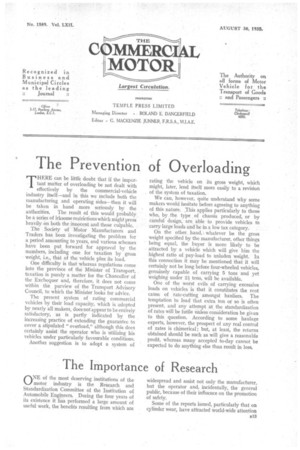The Prevention
Page 19

If you've noticed an error in this article please click here to report it so we can fix it.
of Overloading
THERE can be little doubt that if the important matter of overloading be not dealt with effectively by the commercial-vehicle industry itself—and in this we include both the manufacturing and operating sides—then it will be taken in hand more seriously by the authorities. The result of this would probably be a series of irksome restrictions which might press heavily On both the innocent and those culpable.
The Society of Motor Manufacturers and Traders has• been investigating the problem for a period amounting to years, and various schemes have been put forward for approval by the members, including one for taxation by gross weight, i.e., that of the vehicle plus its load.
One difficulty is that whereas regulations come into the province of the Minister of Transport, taxation is purely a matter for the Chancellor of the Exchequer and, therefore, it does not come within the purview of the Transport Advisory Council, to which the Minister looks for advice.
The present system of rating commercial vehicles by their load capacity, which is adopted by nearly all makers, does not appear to be entirely satisfactory, •as is partly indicated by the increasing practice of extending the guarantee to cover a stipulated " overload," although this does certainly assist the operator who is utilizing his vehicles under particularly favourable conditions.
Anothet suggestion is to adopt a system of rating the vehicle on its gross weight, which might, later, lend itself more easily to a revision of the system of taxation.
We can, however, quite understand why some makers would hesitate before agreeing to anything of this nature. ,This applies particularly to those who, by the type of chassis produced, or by careful design, are able to provide vehicles to carry large loads and be in a low tax category.
On the other, hand, whatever be the gross weight specified by the manufacturer, other things being equal, the buyer is more likely to be attracted by a vehicle which will give him the highest ratio of pay-load to unladen weight. In this connection it may be mentioned that it will certainly not be long before four-wheeled vehicles, genuinely capable of carrying 5 tons and yet weighing under 2i tons, will be available.
One of the worst evils of carrying excessive loads on vehicles is that it constitutes the root cause of rate-cutting amongst hauliers. The temptation• to load that extra ton or so is often present, and any attempt at the standardization of rates will be futile unless consideration be given to this question. According to some haulage experts, however, the prospect of any real control of rates is chimerical ; but, at least, the returns obtained should be such as will give a reasonable profit, whereas many accepted to-day cannot be expected to do anything else than• result in loss.












































































